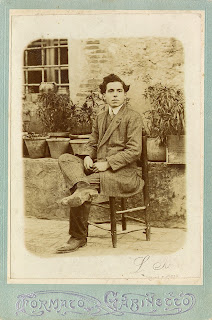
Saturday, March 31
Every time we take an evening stroll, the distant lights of Montecatini
Alto beckon us to come hither, but until today, we have not responded. Several
times we had planned to take a day trip there, but other priorities always
intervened. Nothing else is on our schedule today, so we take the 10 a.m. train
and ride 20 minutes to Montecatini Centro, where we take a leisurely stroll
through town, stopping to buy some gifts for family along the way. Walking to
the base of Montecatini Alto should only take 20 minutes, but it takes us
nearly an hour because of the interesting shops we encounter.
One of the most interesting features of Montecatini Alto is its
historic funicolare, the oldest one in Europe, and it still uses the original two
cars, little red cabs that remind me a bit of the cable cars in San Francisco.
The trains leave every half hour, one starting from bottom and the other from
the top; they pass each other in the middle. The trains consist of a single car
divided into three compartments with seats, but the best views come from an
outside standing-room-only balcony.
Built in 1898 and originally powered by steam, the
funicolare connected the more modern town below with the ancient city above,
which the locals referred to as the “castle.” A powerful electric engine
replaced the steam boiler in 1921. The funicolare suffered serious damages in
1944 when a military unit in retreat set off explosions, putting it out of
service. It reopened in 1949 and became a very popular tourist attraction. It
was out of service for additional improvements from 1987 to 1992, but it has
been in continuous operation since then.
The city below, Montecatini Terme, became a popular resort
town in the late 1800s because of its thermal baths, promoted for both pleasure
and health benefits. Although the spas are not as popular today as they once
were, the fashionable restaurants, hotels, theaters and nightclubs have
remained, and the town continues to draw tourists from all over Italy. We have
been in Montecatini Terme during the evening, and the streets are always packed
with well-dressed young people.
 |
| Colle di Buggiano viewed with a telephoto lens. |
A round-trip ride up the funicolore costs us 7 euro each.
Once at the top, we walk around the perimeter, enjoying the beauty of the
surrounding hillsides and cities. We can see as far as Pistoia to the east and
Montecarlo to the west. I particularly enjoy looking at Colle di Buggiano,
because in my recent genealogical forays, I discovered that my great great grandfather spent some time there. Colle means hill, and the hill above Buggiano is still devoted
to farmland, so we can imagine that one of the farms on the hillside might have
been where Pellegrino and his family lived, along with perhaps many generations
before him.
We end up in the center of town, a large piazza with at
least four restaurants, most of which have outdoor dining. They are a bit
pricey for our budget, but we settle on Il Giardino, which has decent prices
for its primi piatti, though we are surprised to find the Coke that Lucy
ordered cost 3.50 euro. The food is excellent, though, and we take our time to
soak in the atmosphere of this quiet little city. It’s hard to believe that
this city has been the site of numerous bloody battles as various surrounding
powers coveted it for its strategic viewpoint. It once had 25 towers, but all
but a few were destroyed in medieval and renaissance warfare.
 |
| In Montecatini Terme, walking toward the funicolare. |









































